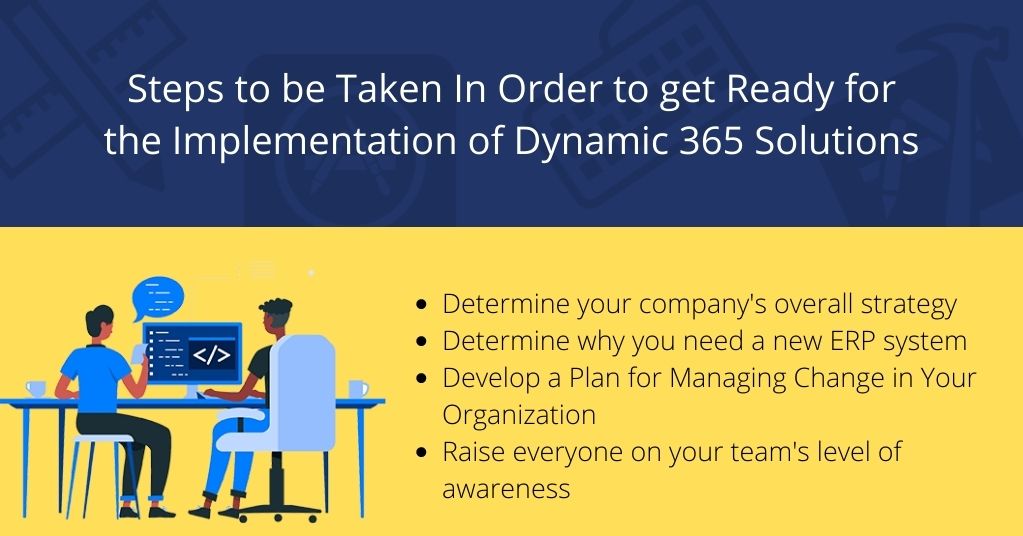If you believe that your organization is prepared to accept change and modernize its primary business system, you will need to have a distinct plan on how to implement this change successfully. For an ERP installation to be successful, internal planning must be thorough, and the company must collaborate with an experienced partner. A corporation absolutely has to have a crystal-clear and well-organized vision of the achievements that they anticipate achieving.
You will need to be prepared in terms of the people, financial, and technological resources available to you in order to speed up the project and achieve success in implementing ERP. During the phase of implementation in which such a massive project is being carried out, a significant amount of work and focus will be required. The pre-configured entities that are included with Dynamics 365 solution include things like Leads, Contacts, Accounts, and Emails, amongst others. Concerning the aspect that deals with the solution, there is a great deal of adaptable elements. The following are the actions that you may know in implementing ERP
1. Determine your company’s overall strategy
To begin, you need to have a company plan, as well as goals and objectives, in order to comprehend why it is that you want modern ERP in the first place. They are the driving force behind the need of ERP installation. During the course of this procedure, you will have the opportunity to learn the following significant detail
– how the installation of ERP fits in with the overall strategy of your company
- the manner in which you plan for the new ERP to communicate with the various other parts of your ecosystem.
- what capabilities need it have in order to address the problems that you are experiencing at the moment?
- what advantages will be gained by your organization as a result of the implementation of a new ERP system?
- the whole price tag of a project that has to be implemented in order to reap those advantages
You and your team may capture all of this information in a single document that will be helpful to everyone throughout the whole process of putting this plan into action. This will allow you to have a more precise picture of what it was from the very beginning that you wanted to accomplish.
2. Determine why you need a new ERP system
It is crucial to identify what problems and concerns need to be solved by the new ERP, and the best way to do this is to speak with different departments within your firm. As a result, you will have an understanding of the primary shortcomings associated with the procedures that are now being followed.
Create a map of your various business processes in order to evaluate how well they will fit with a new enterprise resource planning system. Consider how things may be altered or enhanced so that they do fit in the event that they do not. In addition to this, it is beneficial to investigate which aspects of the current procedure workers depend on the most. After that, you will be able to plan how to ensure that these processes continue to function efficiently for the whole of the implementation.
Create a delivery team by selecting an internal leader for the project and identifying personnel who will be responsible for the different aspects of implementation. Everyone involved absolutely has to have a solid understanding of how difficult the work is and how critical it is to have the procedures correctly aligned. You and the team are able to establish the implementation plan in more detail together.
3. Develop a Plan for Managing Change in Your Organization
The implementation process, in terms of the financial, procedural, technological, and human challenges that are connected with implementing a significant change, will be helped to be better structured thanks to the use of a Roadmap.
The element of human choice is of utmost significance. People need to be flexible and open to new experiences. Your employees need to have a clear view of how the new ERP will affect what they do, and they will need to understand why the firm wants to do it. They will also need to grasp any improvements that will make their own duties simpler and better in the future.
4. Raise everyone on your team’s level of awareness
Think about the practical issues that may affect the schedule of the project, such as business cycles, changes in the seasons, holidays, and annual leave. Create a communication strategy in order to maintain a high level of awareness during each step of the implementation process. To ensure that all of your stakeholders and staff are kept fully informed at all times, you should make use of resources such as newsletters, briefings, frequent meetings, the intranet, and social media. Maintain an open dialogue and make it a priority to address any concerns or questions as soon as they come up.
Bottom Line
Taking steps toward adopting ERP is a challenging endeavour that calls for adequate preparation, a high degree of awareness, and being ready for the changes that will be brought about.
It is possible to ensure that everyone is on the same page and move the process along more quickly by adopting Dynamics 365 Solutions Plan that is both practical and clear, as well as conducting frequent contact with employees and providing them with training. Developing an open and honest working relationship with the provider of your new ERP is another essential step in the process. This step requires you to choose a reliable provider for your new ERP system.
Overall, developing a strategy and acting in accordance with it while working with the team and your provider may be of significant assistance to you in achieving success with the implementation.

